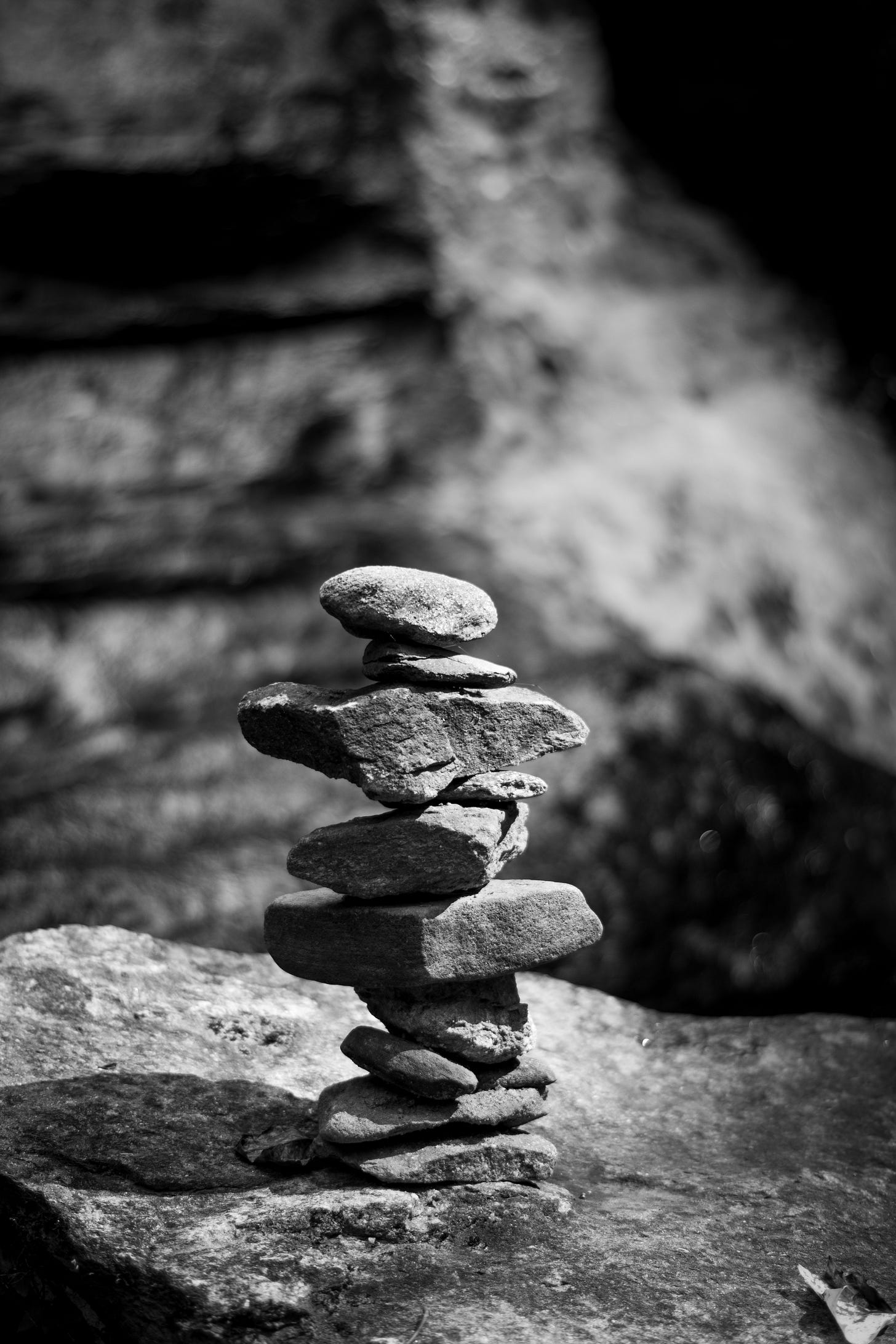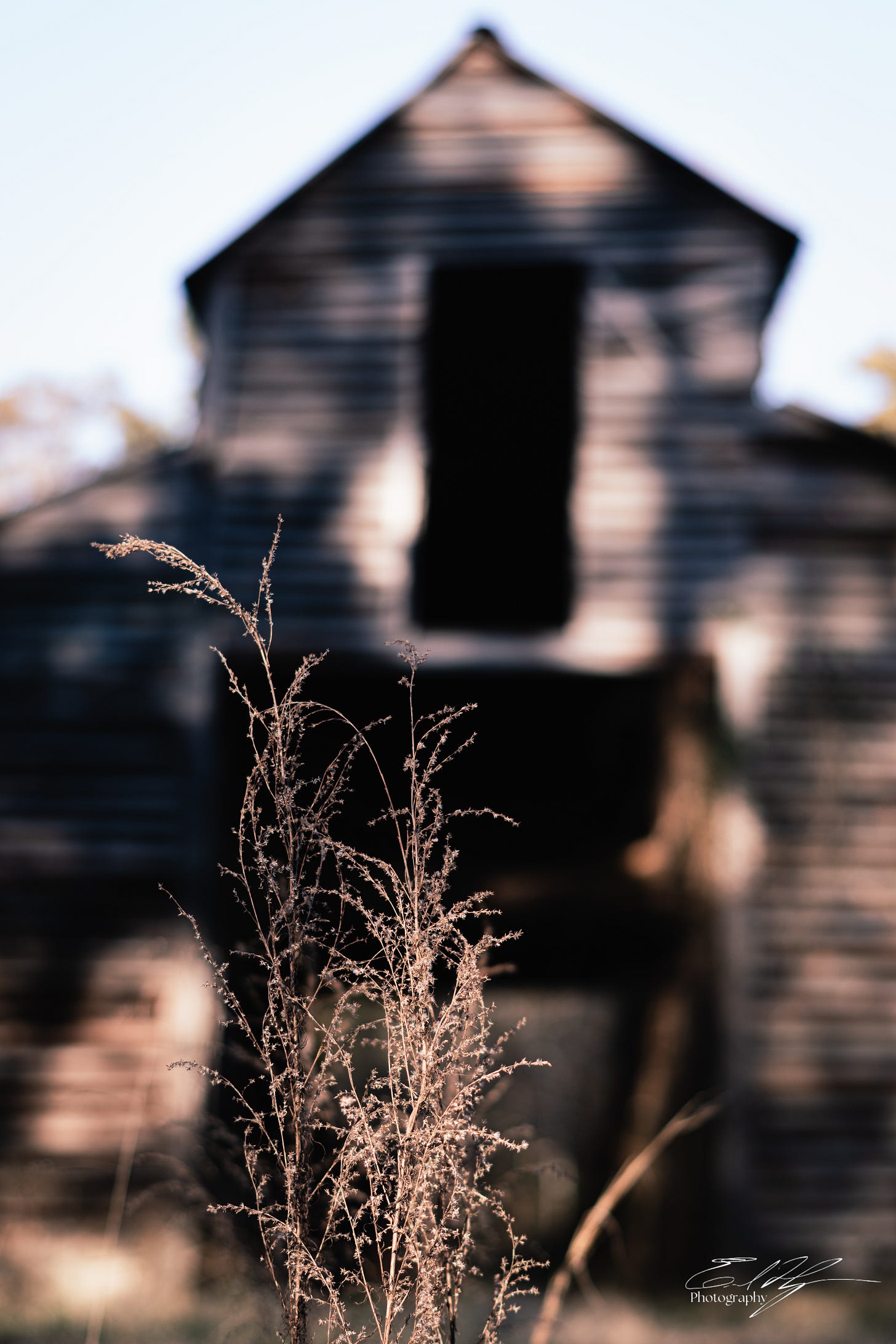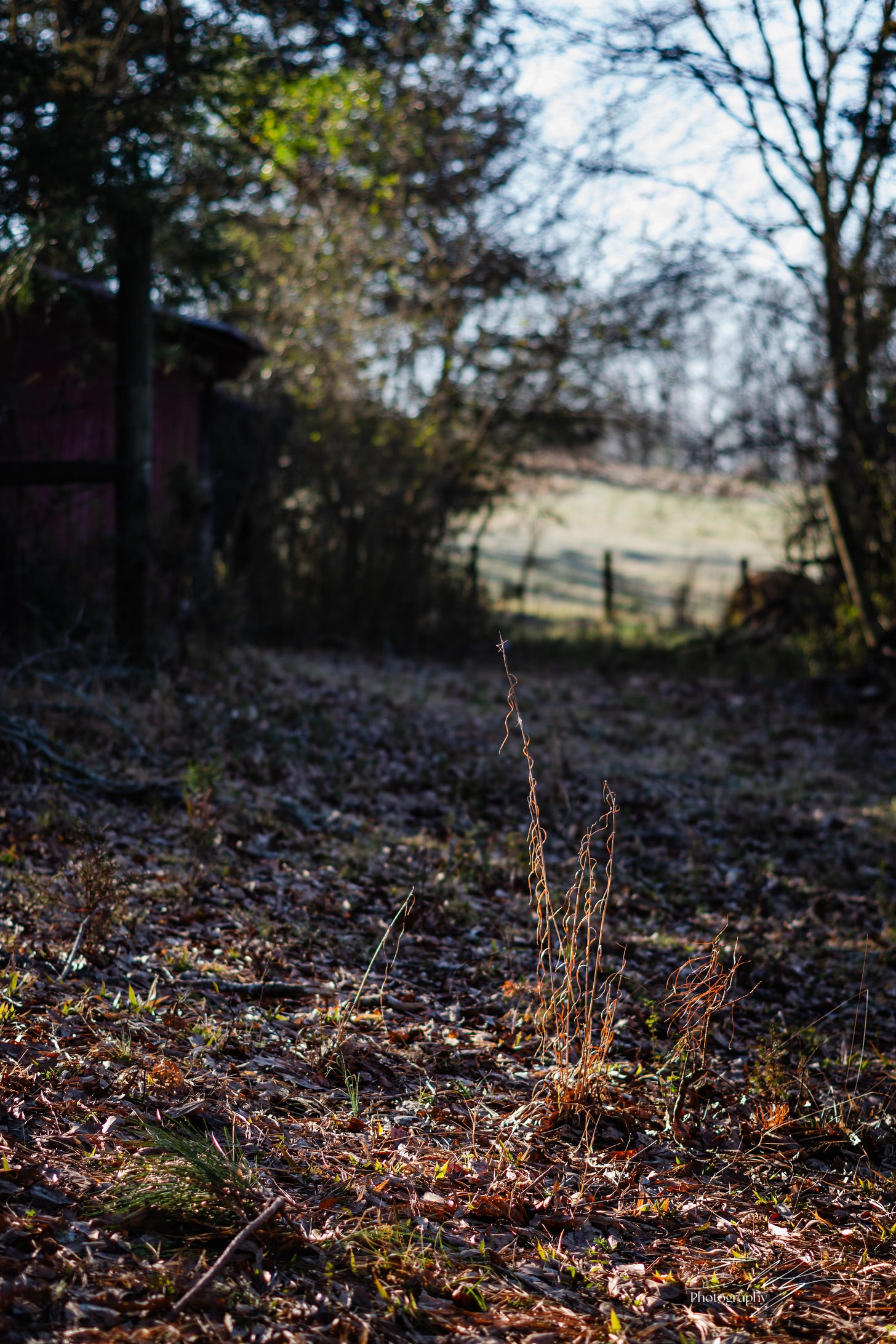Wabi Sabi Stoic Photography I
Field Notes III.X: Exploring a philosophical and aesthetic motif in photography
Welcome to Field Notes!
Lets explore something new
In a time when my travels have been limited, I have been searching for a way to challenge my photographic creativity in the scenes that I encounter ever day. I had several attempts earlier this year that I thought were successful, which I published in past issues of Field Notes. However, those attempts were aided by weather events and utilizing a different camera. Unique opportunities, certainly, but neither of those is a reliable path I want to follow.
Then, I read this essay by
-It is hard to explain, but this concept of both Wabi Sabi and Stoicism in photography presents itself as the perfect path forward at this moment. It incorporates the mental challenge of studying and understanding each of these themes with the artistic challenge of expressing them in photography. That challenge is synergistic, with an aesthetic that for me rings true.
I spent some time studying Japanese culture in high school and college. I studied Japanese language in for a year in college, and I went on a 2 week trip there. Through all of that I have brushed the concept of Wabi Sabi, but never directly learned it.
As most readers know by now, I am a dedicated student of the philosophy of Stoicism. I took Philosophy 101 in college, but don’t even think Stoicism was mentioned. I was introduced to it when I ran across VADM James Stockdale’s accounts of relying on Epictetus’s words as a prisoner of war for seven and a half years during the Vietnam War. If Stoicism could support him through that, it would surely help me as a police officer.
The majority of Stoicism as I understand it has been self taught. I’ve read many books at this point, as well as found some outstanding on line resources and even some excellent publications on Substack, such as Stoicism for Humans above. I have incorporated many of those ideas in my writing in Field Notes. However, until I read the above essay on Wabi Sabi Stoicism it never occurred to me that I could potentially incorporate Stoic themes and ideas in my photography.
So, here we are. What is this? A theme? A project? Maybe a whole new genre? All I can tell you is that this idea of what I am doing here is pretty raw at this stage. I’ve shot an azimuth to the mountain in the distance, but I have no idea what will present itself as I head in that direction. I’m learning as I go, but I want to demonstrate that process in this series.
Here is what we are going to do. I’ll have plenty of regular Field Notes posts going forward, but I will sprinkle in these Wabi Sabi Stoic posts as an indefinite series. I can’t write authoritatively about all of this in an organized manner yet. I’m still learning about Wabi Sabi, Stoicism, and photography as well. I do encourage you to read the essay above for a primer. So, I will write a bit about each of these things as the series progresses and as I learn more about the topics. I have many older photos that I think incidentally embody this aesthetic. I will include some of those in these posts and, obviously, some of my new deliberate attempts. I am excited to see how this path unfolds.
Let’s define some terms
Wabi Sabi is an aesthetic that develped in feudal Japan, closely aligned with Zen Buddhism. Originally, the term Wabi referred to something akin to loneliness in living in nature, away from society. Sabi was defined as “chilled, lean, and withered.” As these terms combined over time into a distinct genre, Wabi Sabi came to mean “the beauty of the impermanent, passing, fragile and modest. The underlying idea became that things are more beautiful for bearing imperfections.”1
There are 7 principles with Wabi Sabi2-
Kanso- Simplicity
Funkinsei- Asymmetry
Shibumi- Beauty in the understated
Shizen- Naturalness
Yugen- Subtle grace
Datsuzoku- Freedom from habits
Seijaku- Tranquility
Wabi Sabi is notoriously hard to precisely define. These are just the principles, and I will be adding to its definition and my understanding grows. Some material describes Wabi Sabi as having a serene melancholy. Others as involving an element of spiritual longing. Many sources, though, characterize Wabi Sabi as-
Nothing lasts. Nothing is finished. Nothing is perfect.
Now for the Stoic element. I won’t even attempt to explain Stoicism as a philosophy in the limited space here. What I will do is quote Dr Polat’s elements of Stoic Wabi Sabi from her essay-
Coexisting harmoniously with environment
Functional and suited to purpose
Organic materials
Craftsmanship that respects the materials (not working against them)
Depiction or suggestion of natural processes (growth, decay, erosion)
Sincerity
Authenticity
Prizing individuality and variety
Ethically produced (not wasteful, respecting people and environment)
Simple, not overly ornamented
I’m certain that when you read over these you will recognize the overlap and alignment. Similar to the way Wabi Sabi was characterized above, I will venture to characterize the Stoic element here, based on my understanding of it at this point-
Embody excellence, regardless of circumstances.
Maybe that works, maybe it doesn’t, but I’m going to use it as a guide for now.
Wabi Sabi is the active recognition of the beauty of the understated in the world around us. Stoicism is a philosophy intended to be lived, not just studied. These are philosophical and aesthetic motifs integrated into the act of doing. They are an embodiment, if you will.
This relates to photography in two ways. The first, and most apparent, is the subject matter. The composition of the images should include subjects that embody the principles of Wabi Sabi and Stoicism. In my efforts this will lean heavily towards nature photography, but I will include man made elements, where appropriate. It will likely be less of the grand landscapes and more of the smaller scenes. Could a staged still life capture Wabi Sabi Stoicism, or is it dependent on points of interest serendipitously found? I don’t know yet, but I may try it in the future and find out.
The second, and more unsuspecting way this motif relates to photography is a different form of the embodiment of the philosophy. The process matters. The WAY the photo is made adds to the achievement of Wabi Sabi Stoicism. It may seem that a photo is a photo and the image speaks for itself. I’m not so sure. Any artist puts a piece of their soul into their works. Who the artist is, how they live, and how they create all matters. You might not be able to point to that element in the work, but I believe it is tangible in some way and gives the work life.
Initially, I will try to achieve a bit of this by primarily photographing with my 50mm prime lens. The reason for this is that I cannot zoom in or out on the subject in order to make a composition. I am forced to adjust myself and my own position in the environment to create the photo. Like stooping to enter the low door of a Japanese tea house, there is poetry in the limitation. This seems like a very good place to start.
Again, this is just a beginning. My thoughts here are guidelines, not hard rules. Over time I hope to discover what works and what does not. I have much more to write, but this is enough words for now. Let’s look at some photos!
A dog and his boy. What I like about this image is that it captures a transient moment in time. As we look, we immediately know that this face to face moment is just that. A moment. It will be over in an instant. I see the subtle grace, naturalness, and tranquility of Wabi Sabi in this pure interaction of the boy and dog. I see the Stoic embodiment of excellence in the sincerity and authenticity of the moment.
Is this photo Wabi Sabi Stoic, or mainly just nostalgic for me? I don’t know. This was a foggy, chill day on September 27, 2020. I was just starting to learn digital photography. I took my kids on a hike up Blood Mountain in North Georgia and brought along a borrowed camera. That boy is now a young man in college. That dog is still an asshole, but he’s getting better.
Nothing lasts.
Believe it or not, I do make some black and white photos from time to time. I cannot capture images in monochrome with my current camera, but convert them in post processing. It seems like a good fit for Wabi Sabi Stoicism.
I found this little rock stack at Nancytown Falls in the Lake Russell Wildlife Management Area in North Georgia on June 26, 2021. The black and white of the image accentuates the textures of the rock. Texture is a key element of Wabi Sabi. We see the precariousness of the stack, knowing that it is fragile and will not last. But from a wider perspective, this image also embodies subtle imperfections. The blurred background beautifully isolates the rock stack as the subject. It is too blurred, however, to show that the background is the cascade of Nancytown Falls. Ah, and then there is the leaf. So easy to eliminate, had I noticed it when I composed the shot. When you see it, you will not forget it.
Nothing is perfect.
Another day of heavy fog. Maybe the moody aesthetic is important to this theme? This was December 4, 2022. I found this lone tree growing on a small island in the North Oconee River in my hometown. The fog separated the subject from the background wonderfully, but I really like how it is even more clear in its reflection in the muddy water.
I would say this little tree embodies excellence, growing to the best of its ability on the tiny bit of land it was given in the midst of the river. I see a subtle grace in its existence. And perseverance.
There is slight motion in the water causing a disturbance in the reflection of the tree. It is an imperfection that I find beautiful and appropriate.
Now let us take a look at a few images I made recently with the goal of a Wabi Sabi Stoic motif.
I would say this image primarily represents the idea of decay over time. It was a good barn, but now stands unused and has become weathered and dilapidated. But, the focus here is on the natural element of the shrub in the foreground. With its dried out stalks in February, it too represents the natural process of decay and death. However, seeing this shrub we somehow have an understanding of hope and renewal when, inevitably, springtime returns.
I made several versions of this photo. Ultimately, I chose this one because it shows the recognizable structure of the barn as opposed to the wood or doorway of an unknown building. I don’t like the sky, though. It adds a third layer of distance and detracts from the simplicity of the subject. That is a big consideration.
Nothing is finished.
I’m not sure about this one. I entered an old shed with an open door to find this blanket resting on a window sill. The textures are superb- the roughness of the cloth in contrast with the grain of the wood it rests upon. I like the coolness of the light falling through the window as opposed to the brighter day outside.
Where I am uncertain is in the depiction of the outside world through the window. As I look at the image I feel separated from the nature beyond. It is subtle, but I feel contained or even trapped. Maybe this one misses the mark?
And finally, this image was an attempt at a broader landscape scene with a Wabi Sabi Stoic theme. Again we have the dry grass in the foreground suggesting natural decay. In the shadows we see an old barn and fence. Perhaps these well worn elements depict a subtle beauty in being structures well suited to their purpose? In the background we have some green in the tree and the open field beyond. This suggests a return of life and growth.
I like this image, but again I am not certain it achieves Wabi Sabi Stocism. I could try to describe elements in it that relate to Stoicism, but it I do not get a Wabi Sabi feel from it.
So, this merely scratches the surface, but is all I will present for now. Sometimes understanding what something is not can be just as vital as knowing what it is. I’m learning and creating. Hopefully some of this inspires you to do the same.
More to follow.
Ok, there is quite a bit of potential for discussion here. I would like to know about your experience with Wabi Sabi. About your ideas of Stoic art. And, I would especially like to hear your thoughts on these photographs and how they either live up to these principles or fall short.
Analyzing my own work in this way really helps me understand what I am striving for and how to improve. However, I recognize that there is a significant chance I am reading into these images elements that do not translate to other viewers. Keep me honest. Let me know!
I put a lot of work into Field Notes and make it available all for free in the hopes that we can learn and grow together. Here are a few ways that you can contribute to help me keep this thing going-
Or, purchase a full resolution digital download of one of my photos with a license for personal use for a print, computer/phone wallpaper, or whatever. Remember, paid subscribers receive select images for free and 50% off of the others.
Menka Sanghvi
https://wearejustlooking.org/wabi-sabi-photography/
Brandon
https://wefreespirits.com/wabi-sabi-principles-meaning/

















Beautiful thoughts and photographs! I think the photo of the old blanket is completely wabi sabi...it looks like it really wants to go outside! Maybe it's remind us of the artificial boundaries we put between ourselves and the natural world? Or how it was discarded by someone who just threw it there, but really it is still useful and still has something to offer the world? It is definitely making a statement of some kind. Also I was thinking about the old headstones from your ancestors post, and those seem very wabi sabi in a memento mori way. Impermanence, death, the processes of nature, weathering, texture...all the Stoic/wabi sabi themes together.
I really love your work and I'm looking forward to seeing where this exploration takes you. Thank you!
Intriguing Erik. I was aware of both philosophies, but look forward to seeing how they come together in your images. My guess is that you will take a lot of photos, and the approach and style for capturing the ideas you want to convey will emerge over time.